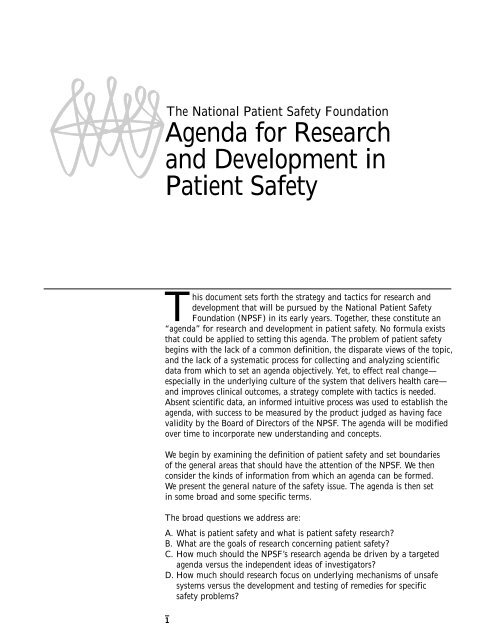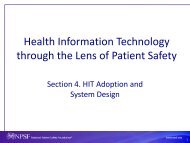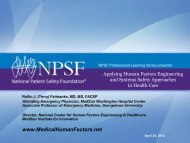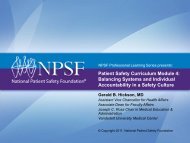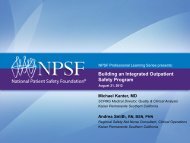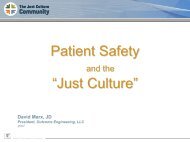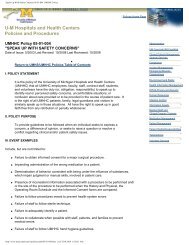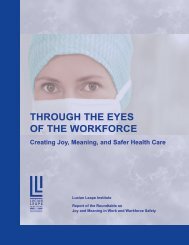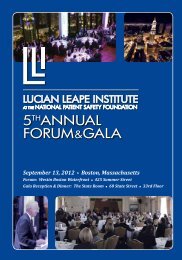Agenda for Research and Development in Patient Safety
Agenda for Research and Development in Patient Safety
Agenda for Research and Development in Patient Safety
- No tags were found...
You also want an ePaper? Increase the reach of your titles
YUMPU automatically turns print PDFs into web optimized ePapers that Google loves.
NPSF <strong>Research</strong> <strong>Agenda</strong>E. What methodologies are appropriate <strong>for</strong> research <strong>in</strong> patient safety?F. By what processes should the research strategy <strong>and</strong> agenda of the NPSFbe developed, ma<strong>in</strong>ta<strong>in</strong>ed, <strong>and</strong> updated so that it is consistent withcontemporaneous needs of the patient safety movement <strong>and</strong> the NPSF?G. By what measures will we know if our goals are be<strong>in</strong>g achieved?A.What is <strong>Patient</strong><strong>Safety</strong>?BackgroundThe term “patient safety” is becom<strong>in</strong>g widely used. As does the term“safety” alone, it means different th<strong>in</strong>gs to different people. Those who<strong>for</strong>med the National <strong>Patient</strong> <strong>Safety</strong> Foundation had <strong>in</strong> m<strong>in</strong>d some concept,<strong>in</strong>dividually <strong>and</strong> collectively, of what is patient safety. Yet, until now, no onehas articulated what constitutes the spectrum of issues to which the NPSFshould give its attention. Where does safety end <strong>and</strong> quality beg<strong>in</strong>? Whatproblems are better addressed <strong>in</strong> a context of medical complications orpublic health? What should be the boundaries of patient safety <strong>in</strong> whichthe NPSF operates its research <strong>and</strong> other programs?Def<strong>in</strong><strong>in</strong>g Characteristics of <strong>Patient</strong> <strong>Safety</strong>Based on these materials, patient safety can be def<strong>in</strong>ed as <strong>in</strong>corporat<strong>in</strong>gthe follow<strong>in</strong>g po<strong>in</strong>ts:1. <strong>Patient</strong> safety has to do primarily with the avoidance, prevention, <strong>and</strong>amelioration of adverse outcomes or <strong>in</strong>juries stemm<strong>in</strong>g from the processesof health care itself. It should address events that span the cont<strong>in</strong>uumfrom what may be called “errors” <strong>and</strong> “deviations” to “accidents”(See model below).2. <strong>Safety</strong> emerges from the <strong>in</strong>teraction of the components of the system. It ismore than the absence of adverse outcomes <strong>and</strong> it is more than avoidanceof identifiable “preventable” errors or occurrences. <strong>Safety</strong> does not resideAccidentsNear MissesDangerous SituationsErrors <strong>and</strong>DeviaionsBattles JB, Kaplan HS, van der Schaaf TW, Shea CE. The attributes of medicalevent-report<strong>in</strong>g systems. Arch Pathol Lab Med. 1998;122:231-238.2
NPSF <strong>Research</strong> <strong>Agenda</strong><strong>in</strong> a person, device or department. Improv<strong>in</strong>g safety depends on learn<strong>in</strong>ghow safety emerges from the <strong>in</strong>teractions of the components.3. <strong>Patient</strong> safety is related to “quality of care”, but the two concepts are notsynonymous. <strong>Safety</strong> is an important subset of quality. To date, activitiesto manage quality, such as quality assurance, cont<strong>in</strong>uous qualityimprovement, total quality management, etc, have not focusedsufficiently on patient safety issues.Us<strong>in</strong>g several <strong>in</strong><strong>for</strong>mation-gather<strong>in</strong>g processes conducted by the NPSF,coupled with historical materials about safety <strong>in</strong> other doma<strong>in</strong>s, the outl<strong>in</strong>esof patient safety can be def<strong>in</strong>ed. These processes are:1. The request <strong>for</strong> Letters of Intent (LOI) to apply <strong>for</strong> grant fund<strong>in</strong>gfrom the NPSF.2. The criteria result<strong>in</strong>g from the NPSF <strong>Research</strong> Program’s deliberations onwhich LOIs to <strong>in</strong>vite to submit full proposals.3. The survey of Program members regard<strong>in</strong>g possible topics to beconsidered as relevant <strong>and</strong> important to patient safety.4. The topics addressed <strong>in</strong> abstracts submitted to the 1998 conferenceon patient safety.5. The presentations at the 1997 Workshop on Assembl<strong>in</strong>g the ScientificBasis <strong>for</strong> Progress on <strong>Patient</strong> <strong>Safety</strong> <strong>and</strong> position papers statements byexperts participat<strong>in</strong>g <strong>in</strong> that conference.Note: The NPSF published a 1998 monograph on the results of this workshop entitled A Tale of Two Stories:Constrast<strong>in</strong>g Views of <strong>Patient</strong> <strong>Safety</strong>. This document is available on its web site at www.npsf.org.Cont<strong>in</strong>uum of <strong>Patient</strong> <strong>Safety</strong><strong>Patient</strong> safety research ef<strong>for</strong>ts span a cont<strong>in</strong>uum from underst<strong>and</strong><strong>in</strong>g theroots of system <strong>and</strong> <strong>in</strong>dividual failure, through develop<strong>in</strong>g <strong>in</strong>terventions tomitigate those failures, to assess<strong>in</strong>g the effect of implementation of errorreduction processes.Examples on the cont<strong>in</strong>uum are:Epidemiology Error Mechanisms Develop<strong>in</strong>g Implementation ofof Error Interventions Error Reduction ProcessesObservational Analysis of Creation <strong>and</strong> trial Effectiveness test<strong>in</strong>gstudies of error technical work of experimental of broadscale<strong>in</strong>cidence report<strong>in</strong>g system report<strong>in</strong>g systemDescriptive studies Analysis of error Creation <strong>and</strong> Effectiveness test<strong>in</strong>gof error typology processes trial of error of simulation <strong>for</strong>reduction process improv<strong>in</strong>g per<strong>for</strong>manceEf<strong>for</strong>ts to improve safety are needed at all po<strong>in</strong>ts along this cont<strong>in</strong>uum.Furthermore, improvement requires an underst<strong>and</strong><strong>in</strong>g of technical work,of organizational factors that <strong>in</strong>fluence the safe conduct of that work <strong>and</strong>,especially, of new vulnerabilities that are <strong>in</strong>troduced whenever an3
NPSF <strong>Research</strong> <strong>Agenda</strong><strong>in</strong>tervention is made. It is not sufficient to suggest implement<strong>in</strong>g solutions toidentified safety problems without assess<strong>in</strong>g how they will work <strong>in</strong> the realworld. <strong>Safety</strong> research must exam<strong>in</strong>e how changes may alter error tolerance,support detection <strong>and</strong> recovery from <strong>in</strong>cipient failure <strong>and</strong> recognize <strong>and</strong>address un<strong>in</strong>tended side effects that create new paths to failure.<strong>Patient</strong> safety research can be def<strong>in</strong>ed <strong>in</strong> two broad categories of problems:safety problems <strong>and</strong> underly<strong>in</strong>g mechanisms. Below is a def<strong>in</strong>ition ofthis rubric of patient safety <strong>and</strong> some examples of issues that are <strong>in</strong> needof attention.<strong>Safety</strong> Problems: Failures <strong>in</strong> specific health areas. Some refer to these as“phenotypes,” ie, the superficial characteristics of the system as opposedto underly<strong>in</strong>g mechanisms:• Prevalence <strong>and</strong> cause of medication errors by health care personnel<strong>in</strong> all sett<strong>in</strong>gs;• Surgery or procedure on wrong part of body;• Errors <strong>in</strong> per<strong>for</strong>mance of hazardous activities (surgery, anesthesia,radiation therapy, etc);• Misdiagnosis;• Selection of <strong>in</strong>appropriate treatment; <strong>and</strong>• Nosocomial <strong>in</strong>fection.Underly<strong>in</strong>g Mechanisms <strong>for</strong> <strong>Safety</strong> Problems: Often called “genotypes”because they are more generic, deeply rooted characteristics of healthcare systems:• Latent failure <strong>in</strong> organizational structure or processes;• <strong>Safety</strong> culture <strong>and</strong> the blame processes;• <strong>Safety</strong> report<strong>in</strong>g, eg, <strong>in</strong>cident report<strong>in</strong>g <strong>and</strong> other mechanisms <strong>for</strong>learn<strong>in</strong>g about systemic vulnerabilities;• Organizational learn<strong>in</strong>g processes <strong>and</strong> barriers;• Production pressure;• Fundamental human limitations-per<strong>for</strong>mance shap<strong>in</strong>g factors;• Fatigue <strong>and</strong> sleep deprivation;• Stress;• Human factors design <strong>in</strong> devices <strong>and</strong> systems;• Coord<strong>in</strong>ation <strong>and</strong> cooperation across people <strong>and</strong> boundaries(coord<strong>in</strong>ation <strong>in</strong>frastruture);• Education <strong>and</strong> tra<strong>in</strong><strong>in</strong>g processes <strong>for</strong> safe procedures; <strong>and</strong>• Special problems of sectors that are severely resource-limited.4
NPSF <strong>Research</strong> <strong>Agenda</strong>Elements of <strong>Research</strong>1. One of the most important approaches to patient safety research is tounderst<strong>and</strong> the nature of technical work, <strong>in</strong>clud<strong>in</strong>g:• The basis <strong>for</strong> expertise <strong>and</strong> success;• The factors that challenge expertise <strong>and</strong> success; <strong>and</strong>• Balanc<strong>in</strong>g a view of the practitioner’s world with a view of the variousaspects of human per<strong>for</strong>mance that play out <strong>in</strong> that sett<strong>in</strong>g.2. This work goes beyond the surface characteristics to discover underly<strong>in</strong>gpatterns of systemic factors that <strong>in</strong>fluence per<strong>for</strong>mance. Develop<strong>in</strong>g thisunderst<strong>and</strong><strong>in</strong>g supports:• Learn<strong>in</strong>g about systemic vulnerabilities when <strong>in</strong>cidents <strong>and</strong>accidents occur;• Anticipat<strong>in</strong>g new areas of concern as change occurs;• F<strong>in</strong>d<strong>in</strong>g deeper <strong>and</strong> more generic patterns <strong>in</strong> failures;• Develop<strong>in</strong>g, prototyp<strong>in</strong>g, <strong>and</strong> evaluat<strong>in</strong>g new approaches; <strong>and</strong>• L<strong>in</strong>k<strong>in</strong>g the patterns <strong>in</strong> these to specific health care contexts.3. Among the <strong>in</strong>terventions that may improve safety per<strong>for</strong>mance orameliorate patient safety problems are (some of which are relatedto issues above):• Improv<strong>in</strong>g mechanisms of patient identification;• Computerized drug order entry;• Bar code scann<strong>in</strong>g of blood products;• Regulation of physician work hours;• Changes <strong>in</strong> health care culture;• Reorganization of health care;• Language barriers <strong>and</strong> cultural differences that may leadto poor provider/patient communications;• New systems of safety report<strong>in</strong>g; <strong>and</strong>• Use of new tra<strong>in</strong><strong>in</strong>g modalities, eg simulation.For some of these, research is needed to prove efficacy; <strong>for</strong> others, researchis needed to test implementation or effectiveness.4. The follow<strong>in</strong>g are examples of issues that are not priorities<strong>for</strong> patient safety:• Problems that are not generally preventable;• Anticipated complications of medical treatment, known side effectsof drugs or of procedural <strong>in</strong>terventions;• An agenda that is much broader than safety;• Reduc<strong>in</strong>g malpractice claims or tort re<strong>for</strong>m*;• Involv<strong>in</strong>g non-serious <strong>in</strong>juries or quality of care alone;• <strong>Patient</strong> satisfaction*; <strong>and</strong>• Reduc<strong>in</strong>g the cost of care** These items could have a priority when they have a direct connection to patient safety or we have def<strong>in</strong>ed it.5
NPSF <strong>Research</strong> <strong>Agenda</strong>B.What are the Goals of<strong>Research</strong> Concern<strong>in</strong>g<strong>Patient</strong> <strong>Safety</strong>?The patient safety movement <strong>and</strong> the NPSF have many goals <strong>in</strong>address<strong>in</strong>g the issues of patient safety. <strong>Research</strong> is an importantcomponent of a broader strategy to improve safety. The term “research”encompasses “development” of techniques <strong>and</strong> <strong>in</strong>terventions <strong>in</strong> additionto the acquisition of new knowledge. In particular, research is needed to:1. Reveal the existence of <strong>and</strong>/or determ<strong>in</strong>e the frequency <strong>and</strong> magnitude ofthe occurrence of known or new safety problems (broadly <strong>in</strong>terpreted thiscould be considered as questions of epidemiology);2. Assess the contribution of underly<strong>in</strong>g human or system characteristicsto safety problems;3. Assess the prevalence of underly<strong>in</strong>g human or system characteristics <strong>in</strong>health care that are analogous to those known to be important arbiters ofsafety <strong>in</strong> other hazardous <strong>in</strong>dustries;4. Develop, pilot test, <strong>and</strong> evaluate techniques or approaches to modifyhuman or system characteristics <strong>in</strong>clud<strong>in</strong>g such items as safety report<strong>in</strong>g,education <strong>and</strong> tra<strong>in</strong><strong>in</strong>g, modified procedures <strong>for</strong> drug order entry, etc; <strong>and</strong>5. Develop, pilot test, <strong>and</strong> evaluate techniques or approaches to ma<strong>in</strong>ta<strong>in</strong>patient safety ef<strong>for</strong>ts as an <strong>in</strong>tegral part of the culture of health caredelivery, similar to what exists <strong>in</strong> the aviation <strong>and</strong> nuclear power <strong>in</strong>dustries.Beyond add<strong>in</strong>g to the actual knowledge <strong>and</strong> techniques generated bypatient safety research support, we must seek to encourage <strong>and</strong> supportresearch <strong>in</strong> patient safety to promote the development of a cadre of experts<strong>and</strong> expertise <strong>in</strong> this area.C.Targeted vs.Investigator-<strong>in</strong>itiated<strong>Research</strong>There are several ways to address the support of research. Two basicstrategies <strong>in</strong>clude:1. Rely on proposals <strong>in</strong>itiated by <strong>in</strong>vestigators, <strong>and</strong>2. Target support to topics deemed important <strong>in</strong> the research agenda.These strategies are not mutually exclusive. There are advantages <strong>and</strong>disadvantages to each. In addition, the decision on which strategies topursue, <strong>and</strong> to what degree, will be dependent on the f<strong>in</strong>ancial resourcesof the Foundation at a given time. Currently, the funds available tosupport research are modest, <strong>and</strong> the field of research <strong>in</strong> patient safetyis <strong>in</strong> its <strong>in</strong>fancy. Thus, the Foundation’s most important role will be as acatalyst, provid<strong>in</strong>g seed money <strong>for</strong> <strong>in</strong>novative work at the “pilot” stage,rather than def<strong>in</strong>itive fund<strong>in</strong>g <strong>for</strong> projects likely to achieve def<strong>in</strong>itive,dramatic results. Success is likely to come from some surpris<strong>in</strong>g directionsrather than “obvious” solutions.1. Investigator-<strong>in</strong>itiated <strong>Research</strong> SupportRely<strong>in</strong>g on <strong>in</strong>vestigator-<strong>in</strong>itiated proposals has many advantages.Investigator-<strong>in</strong>itiated research is the central core of most biomedical research.Programs that allow <strong>for</strong> <strong>in</strong>dividual <strong>in</strong>vestigators to def<strong>in</strong>e the scope of theirprojects solicit ideas from the broadest source possible.6
NPSF <strong>Research</strong> <strong>Agenda</strong>This m<strong>in</strong>imizes the risk of miss<strong>in</strong>g important <strong>and</strong> novel ideas due to preexist<strong>in</strong>gprejudices with<strong>in</strong> the NPSF. It <strong>in</strong>vites participation at the earlieststages from those <strong>in</strong> the best position to carry out the work. It is the mostpowerful way to develop a cadre of <strong>in</strong>vestigators active <strong>in</strong> this arena, s<strong>in</strong>ceit is likely that even <strong>in</strong>vestigators who are unsuccessful <strong>in</strong> receiv<strong>in</strong>g fund<strong>in</strong>gfrom this source will seek fund<strong>in</strong>g elsewhere. It lends itself to the solicitationof <strong>in</strong>novation <strong>and</strong> pilot work that, by necessity, appears to be the NPSF’smost likely current focus.The ma<strong>in</strong> disadvantage of rely<strong>in</strong>g on <strong>in</strong>vestigator <strong>in</strong>itiation is that<strong>in</strong>vestigators may not have the same view of the importance of topicsas does the Foundation itself through its officers <strong>and</strong> <strong>Research</strong> Program.To the extent that NPSF perceived critical topics are not addressed by<strong>in</strong>vestigators’ proposals, research on these topics will be missed.2.Targeted SupportTargeted support has advantages. To the extent that particular topicsor issues can be agreed upon as critical, targeted support can guaranteesolicitation of proposals to address them. Further, targeted support maybe more likely to br<strong>in</strong>g <strong>for</strong>ward the full spectrum of <strong>in</strong>vestigators <strong>and</strong>organizations able to address a particular area. A specific target alsomay lead to higher public visibility <strong>and</strong> be the nucleus <strong>for</strong> rais<strong>in</strong>g funds,possibly allow<strong>in</strong>g more funds to be addressed to the targeted area thanto the diversity of ideas generated by <strong>in</strong>dividual <strong>in</strong>vestigators.The disadvantages of targeted support are: one, that it presumes that thecritical topics or approaches can be articulated; two, that it may tend topromote a parochial view of the broad issues of patient safety; <strong>and</strong> three,that it’s very advantages <strong>in</strong> visibility <strong>and</strong> fund-rais<strong>in</strong>g may tend to squeezeout <strong>in</strong>vestigator-<strong>in</strong>itiated support that may have a benefit <strong>in</strong> the long run.Indeed, <strong>in</strong> a field as young as patient safety, target<strong>in</strong>g research mayartificially narrow the <strong>in</strong>novative <strong>and</strong> creative processes necessary todevelop a susta<strong>in</strong>able patient safety ef<strong>for</strong>t.Among the topics <strong>and</strong> areas that should be considered <strong>for</strong> targetedsupport when resources are available <strong>in</strong>clude:• Incident report<strong>in</strong>g systems;• Medication error;• <strong>Safety</strong> culture;• <strong>Patient</strong> h<strong>and</strong>offs <strong>and</strong> discont<strong>in</strong>uities <strong>in</strong> care;• Missed diagnosis;• Misdiagnosis;• Medical device design;• Coord<strong>in</strong>ation of medical work;• Underst<strong>and</strong><strong>in</strong>g of the nature of expertise; <strong>and</strong>• Analyses of technical work.7
NPSF <strong>Research</strong> <strong>Agenda</strong>3. Other Avenues of <strong>Research</strong> <strong>and</strong> <strong>Development</strong>Independent of these two strategies, there are other avenues by whichthe NPSF may pursue R&D related to patient safety.One is to collaborate with other agencies <strong>in</strong> support<strong>in</strong>g projects that appearlikely to serve the research <strong>and</strong> development goals of the NPSF (regardlessof where those projects are <strong>in</strong>itiated). This approach has the advantage ofleverag<strong>in</strong>g NPSF support via collaboration. Conversely, it runs the risk offund<strong>in</strong>g projects that will already be funded while leav<strong>in</strong>g unfunded novelideas that, largely <strong>for</strong> bureaucratic reasons, have not atta<strong>in</strong>ed fund<strong>in</strong>g byanother source.Another useful strategy is to foster with<strong>in</strong> other agencies the desire toprovide research support themselves <strong>for</strong> projects that would otherwisebe with<strong>in</strong> the purview of the NPSF.4. <strong>Research</strong> conducted directly by or under the adm<strong>in</strong>istration of the NPSFOpportunities will arise <strong>for</strong> research to be conducted directly by or managedby the staff or others directly affiliated with NPSF. That is, the NPSF couldbe considered a research agency rather than merely an agency that supportsresearch. We counsel aga<strong>in</strong>st that at the current time s<strong>in</strong>ce it would dra<strong>in</strong>the very limited adm<strong>in</strong>istrative resources of the NPSF <strong>and</strong> would requireunachievable overhead to be a competitive research organization.D. <strong>Research</strong> on BasicMechanisms vs. Identified<strong>Safety</strong> ProblemsBe<strong>in</strong>g a characteristic of systems, patient safety is a complex phenomenon.The health care systems <strong>in</strong> place today have the characteristics they dobecause of a complicated <strong>in</strong>teraction of organizational, economic, legal,social, <strong>and</strong> technical factors. These systems evolved <strong>in</strong>to their current state<strong>and</strong> no portion of them can be altered easily even if data were available toshow unequivocally the need <strong>for</strong> change.Just as <strong>in</strong> research on diseases, an agenda <strong>for</strong> patient safety research <strong>and</strong>development must achieve a balance between research <strong>and</strong> developmentthat addresses specific avenues to attack currently identified problemsversus research on the fundamental underly<strong>in</strong>g mechanisms that lead to thesub-optimal safety. Ultimately the research on underly<strong>in</strong>g mechanisms canbe more powerful s<strong>in</strong>ce it can, <strong>in</strong> theory, show what characteristics of thesystem must be changed to achieve fundamental alterations <strong>in</strong> the processesof care. However, such research is difficult, will take a long time to achieveany measurable results, will by its nature travel down some bl<strong>in</strong>d alleys,<strong>and</strong> is likely to <strong>in</strong>volve some contentious political issues.<strong>Research</strong> along these l<strong>in</strong>es would focus on such th<strong>in</strong>gs as organizationalstructure <strong>and</strong> process <strong>in</strong> health care, especially <strong>in</strong> comparison to pr<strong>in</strong>ciplesof high reliability organizations. These l<strong>in</strong>es of <strong>in</strong>quiry would try to del<strong>in</strong>eate8
NPSF <strong>Research</strong> <strong>Agenda</strong>exactly what characteristics of the health care system(s) promote errorsor adverse outcomes, which of these characteristics are amenable tomodification, <strong>and</strong> outl<strong>in</strong>e the potential side effects of any modifications.It is likely that this k<strong>in</strong>d of research will <strong>in</strong>volve comparisons of healthcare to other high-hazard activities <strong>in</strong> society, <strong>and</strong> it will be important todeterm<strong>in</strong>e <strong>in</strong> what ways health care is different <strong>in</strong>tr<strong>in</strong>sically <strong>and</strong> irrevocablyfrom other <strong>in</strong>dustries.However, just as medical science does not give up f<strong>in</strong>d<strong>in</strong>g new treatments<strong>for</strong> cancer as it attempts to underst<strong>and</strong> the basic processes of the disease,it is prudent to <strong>in</strong>vestigate the surface level of identified problems <strong>and</strong> tostudy reasonable approaches already available to deal with them. Examplesof these abound, but medication errors <strong>and</strong> procedures on the wrongbody part are two examples that readily come to m<strong>in</strong>d. While a fullunderst<strong>and</strong><strong>in</strong>g of how such events occur (<strong>and</strong> cont<strong>in</strong>ue to occur despitethe <strong>in</strong>dustry’s awareness of the problems) will require a more completeunderst<strong>and</strong><strong>in</strong>g of underly<strong>in</strong>g mechanisms, reasonable approaches existthat may be expected to ameliorate these problems, if admittedly not tocompletely eradicate them.In assess<strong>in</strong>g the proper balance of these activities <strong>for</strong> the NPSF, we shouldbe cognizant that exist<strong>in</strong>g agencies are more likely to fund researchconcern<strong>in</strong>g currently identified problems, whereas there are few fund<strong>in</strong>gagencies to deal with the longer term research on underly<strong>in</strong>g mechanisms.For example, research on medication errors may well be funded byorganizations <strong>in</strong>volved <strong>in</strong> the manufacture, distribution, <strong>and</strong> regulation ofpharmaceuticals. These same organizations are less likely to fund “basic”research on the mechanisms of error <strong>and</strong> error propagation <strong>in</strong> complexorganizations. There<strong>for</strong>e, the Foundation should be careful not to lean tooheavily <strong>in</strong> the direction of research on currently available avenues to attackcurrently identified problems, especially if <strong>in</strong> do<strong>in</strong>g so it would reduce itsability to fund research on fundamental mechanisms with a longer timehorizon, but with more profound potential implications.E. Methodologies <strong>for</strong><strong>Patient</strong> <strong>Safety</strong> <strong>Research</strong>Because catastrophic outcomes are rare <strong>and</strong> measures of preventableoutcomes are difficult to establish, research <strong>in</strong> patient safety does not easilyfit <strong>in</strong>to conventional quantitative models. Thus, all <strong>for</strong>ms of research mustbe considered, <strong>in</strong>clud<strong>in</strong>g those that are quantitative <strong>and</strong> qualitative.Innovation is especially important. <strong>Research</strong> <strong>and</strong> development are needed<strong>in</strong> all areas, <strong>in</strong>clud<strong>in</strong>g the development of new methods <strong>for</strong> underst<strong>and</strong><strong>in</strong>gof basic mechanisms, new measurements <strong>and</strong> ways to test <strong>in</strong>terventions.Underst<strong>and</strong><strong>in</strong>g the “stories” that describe failures <strong>and</strong> digg<strong>in</strong>g <strong>in</strong>tothe deeper issues that are essential to creat<strong>in</strong>g solutions are important.9
NPSF <strong>Research</strong> <strong>Agenda</strong>F. How to Develop <strong>and</strong>Update the <strong>Research</strong><strong>Agenda</strong>The agenda must be set based on a set of research strategies. The agendaitself is a set of tactics to achieve the strategy. The problems encompassed<strong>in</strong> patient safety are so large <strong>and</strong> diffuse as to resist <strong>for</strong>mation of a hardagenda, ie a set of projects that will meet some goal of reduc<strong>in</strong>g patient<strong>in</strong>juries from presumably preventable events. Implementation of tacticswill be molded both by the resources available <strong>in</strong> any year, as well as byopportunities that present themselves.The follow<strong>in</strong>g strategies are the criteria <strong>for</strong> the agenda <strong>for</strong>NPSF-sponsored research.1. Foster <strong>and</strong> encourage <strong>in</strong>vestigator-<strong>in</strong>itiated research. This will secure thebroadest base of research ideas with a constant (yearly) update of themost novel <strong>and</strong> important techniques <strong>and</strong> concerns while foster<strong>in</strong>g thedevelopment of a research cadre. Funded ideas will yield results. Manyunfunded ideas will acquire fund<strong>in</strong>g from other sources. In the first years,NPSF should give priority to proposals that have a more direct path toimplementation <strong>in</strong> patient care, but also support research on moreunderly<strong>in</strong>g mechanisms where the other fund<strong>in</strong>g criteria are strongly met.2. Target one or two special areas that are likely to achieve positive results<strong>in</strong> the time frame of a few years. The topics may arise from unsolicitedproposals to the NPSF or from ideas brought <strong>for</strong>ward by members of theNPSF Board of Directors, programs or committees.3. Leverage the resources of the NPSF by conv<strong>in</strong>c<strong>in</strong>g other fund<strong>in</strong>g sourcesof the importance <strong>and</strong> scientific validity of patient safety research topics.The general basis on which to judge support of projects from any sourceshould be to give priority to those that:1. Have high leverage, eg, large output <strong>for</strong> small <strong>in</strong>put.2. Have a broad impact on the population.3. Improve underst<strong>and</strong><strong>in</strong>g of what is generally referred to aspreventable problems, especially those brought about by humanerror <strong>and</strong> system failures.4. Propose <strong>in</strong>novative <strong>and</strong> creative methods of study or solutions to problems.5. Involve <strong>in</strong>ter-discipl<strong>in</strong>ary research teams.6. Work towards underst<strong>and</strong><strong>in</strong>g or solv<strong>in</strong>g problems <strong>for</strong> which thereare not other sources of fund<strong>in</strong>g.The follow<strong>in</strong>g tactics will implement this strategy:1. Support <strong>in</strong>vestigator-<strong>in</strong>itiated research projects meet<strong>in</strong>g the general criteria<strong>for</strong> research <strong>and</strong> development fund<strong>in</strong>g. At current levels of fund<strong>in</strong>g <strong>for</strong> theresearch program, no less than two grant awards should be made to purely<strong>in</strong>vestigator-<strong>in</strong>itiated projects. This <strong>in</strong>vestigator-<strong>in</strong>itiated research wouldgo through the st<strong>and</strong>ard grant cycle review.2. If the Executive Committee of the Foundation believes that one particulartopic <strong>in</strong> any year is of sufficient importance to warrant a special call <strong>for</strong>10
NPSF <strong>Research</strong> <strong>Agenda</strong>proposals with<strong>in</strong> the current grants program, a sub-solicitation with<strong>in</strong>the overall request <strong>for</strong> proposals (RFP) can be devoted to that topic.Proposals <strong>for</strong> that topic would be evaluated separately from the general<strong>in</strong>vestigator-<strong>in</strong>itiated proposals. The research evaluation of proposalssubmitted under the sub-solicitation should be conducted under theauspices of the <strong>Research</strong> Program, with special guidance <strong>for</strong> prioritiesgiven by the Executive Committee, if necessary.3. If fund<strong>in</strong>g permits, special RFPs can be generated <strong>for</strong> specific topics.This will be especially advantageous <strong>in</strong> situations where the nature ofthe topic can allow sufficient funds to be raised to support morecomplex studies <strong>and</strong> <strong>in</strong>terventions.4. The <strong>Research</strong> Program will develop <strong>and</strong> ma<strong>in</strong>ta<strong>in</strong> a list of currentlyrecognized problems <strong>for</strong> which the Program <strong>and</strong> the Foundation’sExecutive Committee may decide to solicit targeted applications, or <strong>for</strong>which opportunities to collaborate with other organizations may seemparticularly advantageous. This list should not be seen as an exhaustivedef<strong>in</strong>ition of critical issues <strong>in</strong> patient safety.5. The Foundation should be ready to respond to <strong>in</strong>quiries from other agenciesabout potential collaboration on projects that meet the jo<strong>in</strong>t goals of theagencies. It would be advisable to ma<strong>in</strong>ta<strong>in</strong> cont<strong>in</strong>gency fund<strong>in</strong>g available<strong>for</strong> these “targets of opportunity.” When such <strong>in</strong>quiries are received by theNPSF, an ad hoc committee drawn from the members of the <strong>Research</strong>Program should be appo<strong>in</strong>ted <strong>and</strong> convened by the Chair of the <strong>Research</strong>Program to assess whether (1) the <strong>in</strong>quiry is with<strong>in</strong> this document’sframework with regard to patient safety; <strong>and</strong> (2) whether the substantiveproposal is technically feasible. If the <strong>Research</strong> Program Chair determ<strong>in</strong>esthat expertise from the <strong>Research</strong> Program cannot adequately assess theproposal, eg, the proposal requires assessment by experts <strong>in</strong> <strong>and</strong>/or familiarwith other <strong>in</strong>dustries, then the Chair will obta<strong>in</strong> the relevant expertise byaccess<strong>in</strong>g the NPSF National Health Care <strong>Safety</strong> Council. The ad hoccommittee will then provide substantive comments on the proposal witha recommendation as to whether the Board of Directors <strong>and</strong> ExecutiveCommittee should proceed based upon the proposal’s fit with the themes<strong>in</strong> this document <strong>and</strong> the project’s technical rigor.6. The NPSF should <strong>in</strong>itiate meet<strong>in</strong>gs with other biomedical <strong>and</strong> socialresearch fund<strong>in</strong>g agencies, both private <strong>and</strong> governmental, to publicizethe need <strong>for</strong> research on patient safety issues as an important partof a comprehensive strategy of research to improve the health ofthe nation’s citizens.7. Both <strong>in</strong>vestigator-<strong>in</strong>itiated <strong>and</strong> targeted programs should seek a balancebetween research on underly<strong>in</strong>g mechanisms <strong>and</strong> <strong>in</strong>terventions addressedto currently identified problems. On a cont<strong>in</strong>u<strong>in</strong>g basis, the <strong>Research</strong>Program shall assess the projects supported to date <strong>in</strong> terms of thisbalance <strong>for</strong> guidance <strong>for</strong> its own deliberations <strong>and</strong> those of theExecutive Committee.11
NPSF <strong>Research</strong> <strong>Agenda</strong>G. How Will the Successof the <strong>Research</strong> <strong>Agenda</strong>Be Measured?Success is relative. On one level, success should be measured by the<strong>in</strong><strong>for</strong>mation generated by the grant program. Substantive <strong>in</strong><strong>for</strong>mationga<strong>in</strong>ed from projects funded by NPSF will be an important measure asto the direct effects of the grant program. Thus, publications report<strong>in</strong>gthe results of NPSF-funded research will be an important method ofmeasur<strong>in</strong>g the success of the research agenda.The use <strong>and</strong> implementation of such work also are important considerations<strong>in</strong> measur<strong>in</strong>g success: Has the <strong>in</strong><strong>for</strong>mation from the NPSF grant fundedstudies been put to use elsewhere? Have others obta<strong>in</strong>ed similar results <strong>in</strong>their systems? Have others used the study <strong>in</strong><strong>for</strong>mation <strong>in</strong> exp<strong>and</strong>ed <strong>and</strong>extended work? These assessments can be accomplished through adeterm<strong>in</strong>ation of citations of studies us<strong>in</strong>g NPSF funds.A broader goal of the NPSF is education of the public regard<strong>in</strong>g patientsafety. Is the NPSF successful <strong>in</strong> provid<strong>in</strong>g such education? Newsclips,media coverage, survey data <strong>and</strong> public recognition of such activities aremeasures of the NPSF’s success <strong>in</strong> deliver<strong>in</strong>g its message. To enhance itsprobability of success, NPSF must work with other organizations to educatethe public regard<strong>in</strong>g patient safety. Mere recognition of NPSF does notconstitute success.Another related goal is the ability <strong>for</strong> NPSF to <strong>in</strong>crease the visibility ofpatient safety amongst other organizations. Thus, <strong>for</strong> example, expansionof priorities of federal agencies <strong>and</strong> private foundations to <strong>in</strong>clude patientsafety ef<strong>for</strong>ts <strong>in</strong> their own agendas would be an important measure ofsuccess of the NPSF agenda.The National <strong>Patient</strong> <strong>Safety</strong> Foundation(NPSF) is an <strong>in</strong>dependent, nonprofitresearch <strong>and</strong> education organizationdedicated to the measurable improvementof patient safety <strong>in</strong> the delivery ofhealth care. The NPSF was founded <strong>in</strong>1997 by the American MedicalAssociation, CNA HealthPro, <strong>and</strong> 3M.Other major benefactors <strong>in</strong>cludeScher<strong>in</strong>g-Plough Corporation.For more <strong>in</strong><strong>for</strong>mation, contact theNPSF at 312-464-4848 or visit theweb site at www.npsf.orgF<strong>in</strong>ally, <strong>and</strong> most difficult, the NPSF should attempt to determ<strong>in</strong>e whetherthe ef<strong>for</strong>ts <strong>in</strong> its grant program <strong>and</strong> educational activities has an impactupon front l<strong>in</strong>e providers. The best systems <strong>and</strong> report<strong>in</strong>g mechanisms <strong>in</strong> theworld are <strong>in</strong>effective if providers do not recognize them as important, if theyare not accessible to providers, <strong>and</strong> if they are not used by providers. Surveydata that accesses hospital, managed care organization, <strong>and</strong> private practiceadm<strong>in</strong>istrator <strong>and</strong> provider (<strong>in</strong>clud<strong>in</strong>g resident physician) knowledge <strong>and</strong>implementation of patient safety work is essential <strong>in</strong> assess<strong>in</strong>g success.This subject may be a relevant topic <strong>for</strong> NPSF grant fund<strong>in</strong>g.NPSF gratefully acknowledges the ef<strong>for</strong>ts of the 1999 <strong>Research</strong> Program members:Jeffrey Cooper, PhD, ChairMichael Ragan, DMD, JDJoan Fitzmaurice, RN, PhDMatthew Rice, MD, JDDavid Gaba, MDKarlene Roberts, PhDLarry Goldman, MDJane Takeuchi, PhDKenneth Kern, MDAlbert Wertheimer, PhDBryan Liang, MD, PhD, JDDavid Woods, PhDDenise Mart<strong>in</strong>-Sheridan, CRNA, EdDThe NPSF also acknowledges the ef<strong>for</strong>ts of Jill Blim, MS, <strong>and</strong> Laura Blum, MA .© 2000 National <strong>Patient</strong> <strong>Safety</strong> Foundation12


